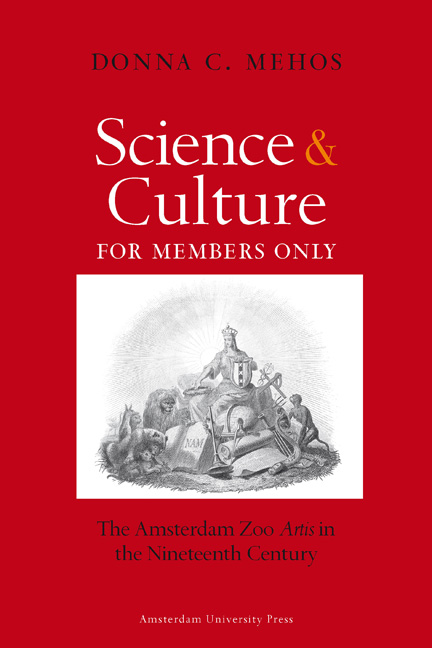Book contents
- Frontmatter
- Dedication
- Contents
- Acknowledgments
- Introduction The Nation and Nature in Middle-Class Culture
- Chapter 1 Structuring a New Generation’s Scientific Society
- Chapter 2 Private Science and the Public Interest
- Chapter 3 Internationalizing Nationalist Science
- Chapter 4 Science Joins Cultural Life
- Conclusion Science, Colonial Expansion, and National Identity
- Appendix: Members of the Artis Board of Directors, 1838-1870
- Notes
- List of Illustrations and Color Plates
- Bibliography
- Index
- Plate Section
Chapter 1 - Structuring a New Generation’s Scientific Society
Published online by Cambridge University Press: 20 January 2021
- Frontmatter
- Dedication
- Contents
- Acknowledgments
- Introduction The Nation and Nature in Middle-Class Culture
- Chapter 1 Structuring a New Generation’s Scientific Society
- Chapter 2 Private Science and the Public Interest
- Chapter 3 Internationalizing Nationalist Science
- Chapter 4 Science Joins Cultural Life
- Conclusion Science, Colonial Expansion, and National Identity
- Appendix: Members of the Artis Board of Directors, 1838-1870
- Notes
- List of Illustrations and Color Plates
- Bibliography
- Index
- Plate Section
Summary
Introduction
In May of 1888, three days of festivities took place to mark the fiftieth anniversary of Amsterdam's zoological garden, the Koninklijk Zoologisch Genootschap Natura Artis Magistra (Royal Zoological Society Nature is the Teacher of Art). Flowers, flags, and banners decorated the neighborhood during the special events. Inside the zoological garden gates, B.J. Stokvis, physiologist and Professor of Medicine at the Municipal University of Amsterdam, extolled the accomplishments of the society in his keynote address. The new building for the society's Ethnographic Museum opened on this occasion, and a select crowd visited the exhibits that had been augmented by the collections of the Colonial Society (Koloniale Vereeniging). An orchestra, choir, and soloists performed the cantata commissioned by the zoo for the celebration. It was written by Daniël de Lange, a leading Dutch composer of the day; J.A. Alberdingk Thijm and W.J. Hofdijk, Amsterdam's literary notables, composed the lyrics sung by distinguished vocalists. The stage was illuminated with gas lights of red, white, and blue – the colors of the Dutch flag. In addition to the zoo's 6,000 members, those present included the Dutch Ministers of Internal Affairs and of Justice, Amsterdam's mayor, representatives of the heads of state of England, France, Germany, and Belgium, the President of the Royal Dutch Academy of Sciences, representatives of foreign zoos, zoological institutions, and animal dealers from England and Germany. This gala – for which the zoo had spared no expense – proved an overwhelming success much like the zoological society that it celebrated. The jubilee represented every facet of the zoo noteworthy for its contemporaries as well as for today's historians. Using zoology, music, and exhibits of colonial nature, Artis had emerged as a cultural center that prominently displayed Dutch science and contributed to national pride.
Founding and Early Expansion
Initiated by three Amsterdam burghers in 1838, the Zoologisch Genootschap Natura Artis Magistra was the first modern zoological garden founded in continental Europe (Illustration 1). As the nineteenth century progressed, Artis housed collections of both living animals and traditional natural history specimens. Its animal collections were enhanced by a library and later an ethnographic museum (1861). Artis's collections and zoological publications, and the research it supported, combined to create the zoo's reputation as an important European center for zoology.
- Type
- Chapter
- Information
- Science and Culture for Members OnlyThe Amsterdam Zoo Artis in the Nineteenth Century, pp. 21 - 34Publisher: Amsterdam University PressPrint publication year: 2006



